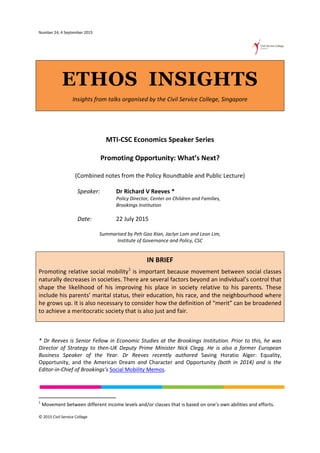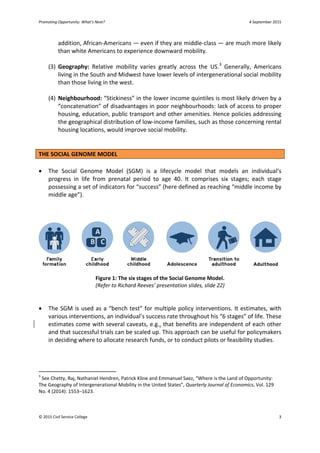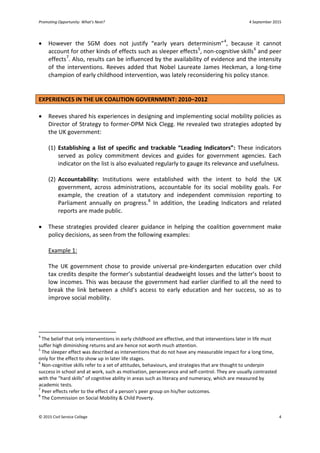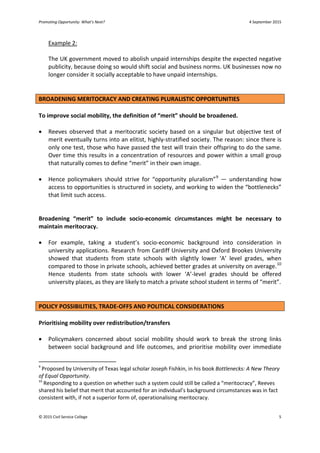Ethos Insights - Social Mobility Talk Summary by Dr Richard Reeves
- 1. Number 24, 4 September 2015 ETHOS INSIGHTS Insights from talks organised by the Civil Service College, Singapore MTI-CSC Economics Speaker Series Promoting Opportunity: WhatŌĆÖs Next? (Combined notes from the Policy Roundtable and Public Lecture) Speaker: Dr Richard V Reeves * Policy Director, Center on Children and Families, Brookings Institution Date: 22 July 2015 Summarised by Peh Gao Xian, Jaclyn Lam and Leon Lim, Institute of Governance and Policy, CSC IN BRIEF Promoting relative social mobility1 is important because movement between social classes naturally decreases in societies. There are several factors beyond an individualŌĆÖs control that shape the likelihood of his improving his place in society relative to his parents. These include his parentsŌĆÖ marital status, their education, his race, and the neighbourhood where he grows up. It is also necessary to consider how the definition of ŌĆ£meritŌĆØ can be broadened to achieve a meritocratic society that is also just and fair. * Dr Reeves is Senior Fellow in Economic Studies at the Brookings Institution. Prior to this, he was Director of Strategy to then-UK Deputy Prime Minister Nick Clegg. He is also a former European Business Speaker of the Year. Dr Reeves recently authored Saving Horatio Alger: Equality, Opportunity, and the American Dream and Character and Opportunity (both in 2014) and is the Editor-in-Chief of BrookingsŌĆÖs Social Mobility Memos. 1 Movement between different income levels and/or classes that is based on oneŌĆÖs own abilities and efforts. ┬® 2015 Civil Service College
- 2. Promoting Opportunity: WhatŌĆÖs Next? 4 September 2015 WHY RELATIVE SOCIAL MOBILITY? ŌĆó Relative social mobility across generations will become more of a social issue as slower economic growth brings lower absolute mobility, and also as society becomes more rigid over time, with less movement between social classes. ŌĆó Parents in the top tiers of society have strong incentives to ŌĆ£work every system in societyŌĆØ to ensure their children do not slide down the income distribution curve. The result: a ŌĆ£glass floorŌĆØ for those at the top, which doubles as a ŌĆ£glass ceilingŌĆØ preventing the less advantaged from rising in socio-economic status. ŌĆó This societyŌĆÖs economic competitiveness might decline in the long run. For example, VeniceŌĆÖs economic decline can be traced to the monopolisation of trade by her nobles in 1315. Before this event ŌĆö called ŌĆ£La SerrataŌĆØ or ŌĆ£The ClosingŌĆØ ŌĆö merchants from humble backgrounds could form trading relationships with nobility. These relationships played a major role in making Venice a vibrant and thriving city-state. However, as political power and wealth grew increasingly concentrated, the egalitarian institutions that had made Venice wealthy eroded, and the city eventually declined as a maritime and economic power. INTERNATIONAL MOBILITY "STICKINESS" ŌĆó The US data on intergenerational mobility2 displays ŌĆ£stickinessŌĆØ at both ends of the income distribution, i.e., children from families at both ends of the income distribution curve are likely to remain where they are. This can be explained by the following factors: (1) ParentsŌĆÖ marital status: The significance of marriage seems to lie in its importance as an institution that facilitates stability, shared resources, parental planning and investment in children. Reeves calculated that children of poor and unwed mothers in the US have a 50 per cent chance of remaining in the bottom 20 per cent of the income distribution curve. Corresponding statistics of children from wedded mothers are lower: 32 per cent (remarriages) and 17 per cent (long term marriages). (2) Education and race: Education alone is insufficient to offset the effects of an individualŌĆÖs social-economic background. Children from the top 20 per cent of the income distribution curve have a 14 per cent chance of remaining where they are even without a college degree. On the other hand, children from the bottom 20 per cent have a 16 per cent chance of remaining at the bottom even with a degree. In 2 Many of the statistics in this section were derived by Reeves and his team and reported in the Brookings essay ŌĆ£Saving Horatio AlgerŌĆØ, authored by Reeves. The essay is available at http://www.brookings.edu/research/essays/2014/saving-horatio-alger. For more information on how the statistics were derived, see http://www.brookings.edu/blogs/social-mobility-memos/posts/2014/08/21-data- behind-saving-horatio-alger-reeves ┬® 2015 Civil Service College 2
- 3. Promoting Opportunity: WhatŌĆÖs Next? 4 September 2015 addition, African-Americans ŌĆö even if they are middle-class ŌĆö are much more likely than white Americans to experience downward mobility. (3) Geography: Relative mobility varies greatly across the US.3 Generally, Americans living in the South and Midwest have lower levels of intergenerational social mobility than those living in the west. (4) Neighbourhood: ŌĆ£StickinessŌĆØ in the lower income quintiles is most likely driven by a ŌĆ£concatenationŌĆØ of disadvantages in poor neighbourhoods: lack of access to proper housing, education, public transport and other amenities. Hence policies addressing the geographical distribution of low-income families, such as those concerning rental housing locations, would improve social mobility. THE SOCIAL GENOME MODEL ŌĆó The Social Genome Model (SGM) is a lifecycle model that models an individualŌĆÖs progress in life from prenatal period to age 40. It comprises six stages; each stage possessing a set of indicators for ŌĆ£successŌĆØ (here defined as reaching ŌĆ£middle income by middle ageŌĆØ). Figure 1: The six stages of the Social Genome Model. (Refer to Richard ReevesŌĆÖ presentation slides, slide 22) ŌĆó The SGM is used as a ŌĆ£bench testŌĆØ for multiple policy interventions. It estimates, with various interventions, an individualŌĆÖs success rate throughout his ŌĆ£6 stagesŌĆØ of life. These estimates come with several caveats, e.g., that benefits are independent of each other and that successful trials can be scaled up. This approach can be useful for policymakers in deciding where to allocate research funds, or to conduct pilots or feasibility studies. 3 See Chetty, Raj, Nathaniel Hendren, Patrick Kline and Emmanuel Saez, ŌĆ£Where is the Land of Opportunity: The Geography of Intergenerational Mobility in the United StatesŌĆØ, Quarterly Journal of Economics, Vol. 129 No. 4 (2014): 1553ŌĆō1623. ┬® 2015 Civil Service College 3
- 4. Promoting Opportunity: WhatŌĆÖs Next? 4 September 2015 ŌĆó However the SGM does not justify ŌĆ£early years determinismŌĆØ4 , because it cannot account for other kinds of effects such as sleeper effects5 , non-cognitive skills6 and peer effects7 . Also, results can be influenced by the availability of evidence and the intensity of the interventions. Reeves added that Nobel Laureate James Heckman, a long-time champion of early childhood intervention, was lately reconsidering his policy stance. EXPERIENCES IN THE UK COALITION GOVERNMENT: 2010ŌĆō2012 ŌĆó Reeves shared his experiences in designing and implementing social mobility policies as Director of Strategy to former-DPM Nick Clegg. He revealed two strategies adopted by the UK government: (1) Establishing a list of specific and trackable ŌĆ£Leading IndicatorsŌĆØ: These indicators served as policy commitment devices and guides for government agencies. Each indicator on the list is also evaluated regularly to gauge its relevance and usefulness. (2) Accountability: Institutions were established with the intent to hold the UK government, across administrations, accountable for its social mobility goals. For example, the creation of a statutory and independent commission reporting to Parliament annually on progress.8 In addition, the Leading Indicators and related reports are made public. ŌĆó These strategies provided clearer guidance in helping the coalition government make policy decisions, as seen from the following examples: Example 1: The UK government chose to provide universal pre-kindergarten education over child tax credits despite the formerŌĆÖs substantial deadweight losses and the latterŌĆÖs boost to low incomes. This was because the government had earlier clarified to all the need to break the link between a childŌĆÖs access to early education and her success, so as to improve social mobility. 4 The belief that only interventions in early childhood are effective, and that interventions later in life must suffer high diminishing returns and are hence not worth much attention. 5 The sleeper effect was described as interventions that do not have any measurable impact for a long time, only for the effect to show up in later life stages. 6 Non-cognitive skills refer to a set of attitudes, behaviours, and strategies that are thought to underpin success in school and at work, such as motivation, perseverance and self-control. They are usually contrasted with the ŌĆ£hard skillsŌĆØ of cognitive ability in areas such as literacy and numeracy, which are measured by academic tests. 7 Peer effects refer to the effect of a personŌĆÖs peer group on his/her outcomes. 8 The Commission on Social Mobility & Child Poverty. ┬® 2015 Civil Service College 4
- 5. Promoting Opportunity: WhatŌĆÖs Next? 4 September 2015 Example 2: The UK government moved to abolish unpaid internships despite the expected negative publicity, because doing so would shift social and business norms. UK businesses now no longer consider it socially acceptable to have unpaid internships. BROADENING MERITOCRACY AND CREATING PLURALISTIC OPPORTUNITIES To improve social mobility, the definition of ŌĆ£meritŌĆØ should be broadened. ŌĆó Reeves observed that a meritocratic society based on a singular but objective test of merit eventually turns into an elitist, highly-stratified society. The reason: since there is only one test, those who have passed the test will train their offspring to do the same. Over time this results in a concentration of resources and power within a small group that naturally comes to define ŌĆ£meritŌĆØ in their own image. ŌĆó Hence policymakers should strive for ŌĆ£opportunity pluralismŌĆØ9 ŌĆö understanding how access to opportunities is structured in society, and working to widen the ŌĆ£bottlenecksŌĆØ that limit such access. Broadening ŌĆ£meritŌĆØ to include socio-economic circumstances might be necessary to maintain meritocracy. ŌĆó For example, taking a studentŌĆÖs socio-economic background into consideration in university applications. Research from Cardiff University and Oxford Brookes University showed that students from state schools with slightly lower ŌĆśAŌĆÖ level grades, when compared to those in private schools, achieved better grades at university on average.10 Hence students from state schools with lower ŌĆśAŌĆÖ-level grades should be offered university places, as they are likely to match a private school student in terms of ŌĆ£meritŌĆØ. POLICY POSSIBILITIES, TRADE-OFFS AND POLITICAL CONSIDERATIONS Prioritising mobility over redistribution/transfers ŌĆó Policymakers concerned about social mobility should work to break the strong links between social background and life outcomes, and prioritise mobility over immediate 9 Proposed by University of Texas legal scholar Joseph Fishkin, in his book Bottlenecks: A New Theory of Equal Opportunity. 10 Responding to a question on whether such a system could still be called a ŌĆ£meritocracyŌĆØ, Reeves shared his belief that merit that accounted for an individualŌĆÖs background circumstances was in fact consistent with, if not a superior form of, operationalising meritocracy. ┬® 2015 Civil Service College 5
- 6. Promoting Opportunity: WhatŌĆÖs Next? 4 September 2015 redistribution or social transfers. Although these decisions would be politically tough, Reeves highlighted that payments from a government to its people on their own, are insufficient to change individual behaviour or address the ŌĆ£concatenationŌĆØ of economic, geographical and social disadvantages affecting the social mobility of low-income families. Policymakers need to also consider how policy measures affect oneŌĆÖs access to opportunities.11 Simplifying rules and managing planned disruptions ŌĆó Policymakers should simplify systems to key services such as education and healthcare, so as to benefit as many people as possible. This is because complex systems tend to favour those with greater resources. For example, in SingaporeŌĆÖs Primary 1 registration exercise, rich and educated parents tend to best understand all the rules, or can spare the time to volunteer in the schools they have earmarked for their children. ŌĆó Reeves drew a distinction between regulating top income earners and their influence. He suggested government invention is needed only in areas where ŌĆ£the 1 per cent is rigging the systemŌĆØ, e.g., through zoning laws and alumni preferences for school admissions. This is analogous to how regulators want companies to be competitive but not form cartels. 11 Reeves also praised SingaporeŌĆÖs policy of spreading out rental housing across different geographical areas, to ensure that Singaporeans there were still able to access good public amenities. ┬® 2015 Civil Service College 6
- 7. Promoting Opportunity: WhatŌĆÖs Next? 4 September 2015 ┬® 2015 Civil Service College, Singapore. All rights reserved. No part of this article may be reproduced, modified, stored in a retrieval system, or transmitted in any form by any means, electronic, mechanical, photocopying, recording or otherwise, without the prior written permission of the Civil Service College, Singapore. For enquiries, please contact: Institute of Governance and Policy Civil Service College, Singapore, 31 North Buona Vista Road Singapore 275983 Website: www.cscollege.gov.sg or www.facebook.com/CivilServiceCollegeSingapore ┬® 2015 Civil Service College 7






